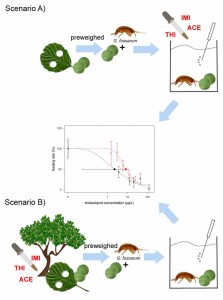In this post, PhD student Dominic Englert shares his poster „Effects of systemic neonicotinoid insecticides: the importance of exposure pathways“ that he presented during the 15th EuCheMS International Conference on Chemistry and the Environment in Leipzig, Germany.
“In this study, the key leaf-shredding invertebrate Gammarus fossarum (Amphipoda) was exposed to three different neonicotinoid insecticides (i.e., thiacloprid (THI), imidacloprid (IMI) and acetamiprid (ACE)) either via the water phase (scenario A) or contaminated leaves (from neonicotinoid-treated trees; scenario B) to assess for potential toxicological differences of these two exposure pathways.
7-d EC50s were derived from dose-response curves for the feeding rate of Gammarus based on concentrations measured in the respective water phase and finally compared for both exposure scenarios. Comparisons of dose-response curves indicate that the adverse effect on the amphipods’ feeding – resulting from ingestion of contaminated leaves together with exposure to neonicotinoids leached from leaves into water (scenario B) – differs from those of exposure via the water phase alone.
For more info, see our poster, which can be downloaded via the link below:

